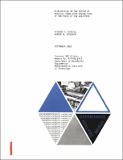Film boiling on the inside of vertical tubes with upward flow of the fluid at low qualities
Author(s)
Dougall, R. S.; Rohsenow, Warren M.
DownloadHTL_TR_1963_026a.pdf (6.320Mb)
Other Contributors
Massachusetts Institute of Technology. Dept. of Mechanical Engineering.
Massachusetts Institute of Technology. Heat Transfer Laboratory.
Metadata
Show full item recordAbstract
Flow regimes, local heat transfer coefficients, and temperature distributions along the wall have been studied for film boiling inside a vertical tube with upward flow of a saturated liquid. The area of interest has been limited to cases of constant heat flux from the tube wall, small inlet liquid velocities, and film boiling which completely covers the entire heated portion of the tube. The last restriction means that there is no large region of nucleate boiling prior to the film boiling section. A visual test section made of electrically conducting glass tubing has been used for flow visualization studies at low qualities. Visual observations with this test section have indicated that the flow regime is annular with liquid in the center and vapor along the walls of the tube. Based on interpretations of temperature distribution data, it has been concluded that the annular flow regime changes at higher qualities to one of dispersed flow--where the liquid is dispersed in the form of drops through a predominately vapor flow. Two different diameter test sections made of stainless steel and heated electrically have been used to obtain experimental data of temperature distributions along the tube wall and local Nusselt numbers for different heat fluxes and flow rates. The fluid used in all the experimental tests has been freon 113. For the larger tube, 0.408" I.D., heat fluxes have been varied from 14,400 to 25,600 Btu/hr-ft2 , and mass velocities have been varied from 482,000 to 818,000 lbm/hr-ft2 . For these conditions, values of heat transfer coefficients from 24.0 to 41.4 Btu/hr-ft 2 -*F and values of Tw-Ts from 407 to 697*F have been obtained. These conditions have resulted in exit qualities up to 10 per cent. For the smaller tube, 0.180" I.D., heat fluxes have been varied from 22,500 to 41,800 Btu/hr-ft2 , and mass velocities have been varied from 332,000 to 398,000 lbm/hr-ft". For these conditions, values of heat (cont.) transfer coefficients from 27.0 to 87.5 Btu/hr-ft2 -*F and values of Tw-T from 261 to 883*F have been obtained. These conditions have resulted in exit qualities up to 50 per cent. A theoretical derivation based on an annular flow model with turbulent flow in the vapor film has given good agreement with the experimental data at low qualities. A dispersed flow theory using a modified form of the Dittus and Boelter-McAdams equation seems to be an asymptote which the experimental data approaches with increasing qualities.
Date issued
1963Publisher
Cambridge, Mass. : Dept. of Mechanical Engineering, Massachusetts Institute of Technology, [1963]
Other identifiers
23887551
Series/Report no.
Technical report (Massachusetts Institute of Technology, Heat Transfer Laboratory) ; no. 26a.